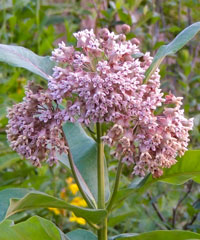 | | Common milkweed |
2014 Shopping GuideDon't forget to use our Native Plant Shopping Guide when you shop for native plants (more information below). Wherever you shop, be sure the plants are pesticide-free. In fact, Minnesota recently passed a law making it illegal to sell plants labeled as "Bee-Friendly" but which are infused with systemic pesticides. ( Read more in a Minnesota Public Radio story.)  Janet Allen, President, HGCNY
|
|
Mystery photo - answer at the end
|
|
The outlook for monarchs this year & beyond
|
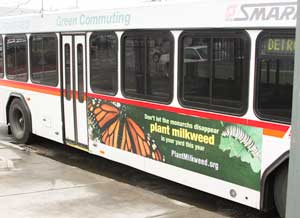 If you were to go to Detroit, you might see this unusual ad on a city bus. "Don't let the monarch disappear, plant milkweed in your yard this year" it proclaims. An additional ad on another bus shows a monarch caterpillar and says, "All dressed up and nowhere to go ... Plant milkweed." How did these ads get there? By an inspiring bit of stewardship by a fellow Wild Ones member, Fred Kaluza, who used his year-end bonus to buy these ads encouraging people to plant milkweed! Monarchs so far this year
Visit Journey North to see an animated map of their weekly progress as they make their way north to their summer breeding territory. As you'll see, for some reason, they generally make a belated entrance to CNY compared to other areas at a similar latitude, but they should be getting here in the next few weeks. When you do see your first monarch, you can report it on the Journey North website. Although, as Dr. Chip Taylor says, bringing back the monarchs will take a national effort over many years, not just a token response, things are looking good for egg production this year so far. As the Journey North news reports, "The number of reports is encouraging, especially when compared to last spring at this time." In the long term, Dr. Taylor notes that it will be crucial to 1) offset the losses of milkweed due to development and expansion of croplands, and 2) maintain the milkweed corridor that sustain the monarchs. He notes that, " A token response to the problem will not get the job done. We need all hands on deck. Bringing Back the Monarchs has to become a national effort." And it's good to know that everything we do to help monarchs helps other pollinators, too. |
 |
 |
 |
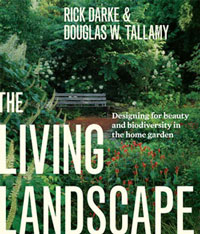 Just Released: The "How to" sequel to Tallamy's Bringing Nature Home Just Released: The "How to" sequel to Tallamy's Bringing Nature Home
Bringing Nature Home: How You Can Sustain Wildlife with Native Plants has influenced many people since its publication in 2007. Now Tallamy has teamed up with Rick Darke, a prominent landscape designer to offer The Living Landscape: Designing for Beauty and Biodiversity in the Home Garden.From the Amazon description:Written by Rick Darke and Douglas W. Tallamy, two of the most important voices in sustainability and horticulture, it is the definitive guide to designing a beautiful, biodiverse home garden. The authors first explain the layers of the landscape and what role the plants within them plays in the larger environment, from providing berries for birds, food for bugs, or a place for bees to pollinate. The authors then put this information into context and offer design strategies to implement in a home garden. Helpful charts suggest plants, including natives and nonnatives, for each region. Douglas W. Tallamy's award-winning Bringing Nature Home revealed the pressing need for a biodiverse home landscape. In a gorgeously illustrated, inspirational, and practical way, The Living Landscape supports the important message by showing gardeners how to make it happen. And for pollinators 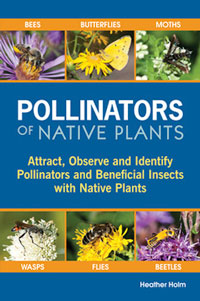 Inspired by Tallamy's original book, Heather Holm has focused in on the relationship between native plants and pollinators with the book Pollinators of Native Plants: Attract, Observe and Identify Pollinators and Beneficial Insects with Native Plants. (She also generously donated copies of the book for our local libraries!) From the Amazon description:This is the first comprehensive book to illustrate the specific relationships between native pollinators and native plants. Organized by plant communities, the book profiles over 65 perennial native plants of the Midwest, Great Lakes region, Northeast and southern Canada and the pollinators, beneficial insects and flower visitors the plants attract. With its easy-to-use format, the book provides the reader with information on how to attract, plant for and identify pollinators with native plants. Beautifully designed and illustrated with over 1600 photos of plants and insects, the book includes information on pollination, types of pollinators and beneficial insects, pollinator habitat and conservation as well as pollinator landscape plans. This is an important book for gardeners, students, native plant enthusiasts, landscape restoration professionals, small fruit and vegetable growers and farmers who are interested in attracting, identifying, supporting or planting for pollinators.
|
|
2014 Native Plant Shopping Guide
|
Our FREE guide is ready for download!
 What question do we get asked most often? Where can I find native plants. Now you'll know! What question do we get asked most often? Where can I find native plants. Now you'll know!
Our 2014 Guide has the same general format as our previous Guides with a few new codes:
- F indicates Pesticide-Free plants
- BB indicate plants especially good for bumble bees. Both qualities are important.
Click on the photo above or HERE to download the entire Guide as one .pdf file.
OR you can download any or all of the parts separately for printing.
Here are the THREE PARTS of this guide:
If your computer downloads the files, but you don't know where they are, look in your browser settings to find your Downloads folder.
Still having trouble? Contact us and we'll email the .pdf file to you directly.
The Introduction section
Whether or not you print it out, please read the Introduction for Shopping Tips, contact information for the vendors and other helpful information.
We recommend that you CALL AHEAD before you set out on your shopping trip! Confirm the hours the nurseries are open and confirm that your selected plants are currently in stock. What is available in May, for example, may not be available in July. Call ahead to avoid disappointments and wasted gas!
Thank you for patronizing our local native plant nurseries. Supporting these nurseries is an important way to grow the native plant movement.
|
 |
 |
 |
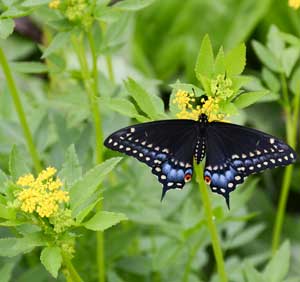 | Black swallowtail and zizia, one of its host plants
|
Answer: The orange "eyes" in the photo at the top of the newsletter are markings on the wings of a black swallowtail butterfly. This particular butterfly just emerged in mid-May after spending the cold winter in its chrysalis. Different butterflies overwinter in different stages of development -- some as eggs, some as caterpillars, some as pupae, and some as adult butterflies, so a variety of habitat is an important part of good butterfly habitat. (And not raking up leaf litter--along with overwintering butterflies--is a good gardening practice.) Butterfly resources often list dill, fennel, Queen Ann's lace, and parsley as host plants for this butterfly. (A "host plant" is the specific type or types of plants a butterfly's caterpillars is able to eat.) These non-native plants are host plants, but a native host plant for the black swallowtail caterpillars is Zizia aurea and Z. aptera, also known as golden alexander and heart-leaved alexanders respectively (but it's more fun to say "zizia"!) Good butterfly habitat needs host plants. No host plants, no butterflies! Yes, the leaves will be eaten, but it won't kill the plant. After all, how could any creature have survived for millions of years if it killed the plants it depended on? Butterflies of Onondaga CountyWhen you're trying to identify butterflies you see, it's helpful to know which species are likely to be seen here in Onondaga County. Butterflies and Moths of North America has regional checklists of butterflies on their website. The Onondaga County butterflies are on this page of that website.
|
|
|
|
Start planning for our HGCNY fall plant sale
|
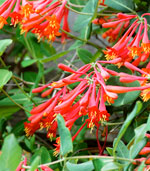 | Native coral honeysuckle
(Lonicera sempervirens) |
It's not too early to starting thinking about our fall plant sale.
Here are two ways you can help:
1) Think about which plants you would like to purchase at our sale. We'll try to have them available if we find a source. Email John with your requests. 2) As you observe your plantings this spring and summer, note which plants you'd like to donate to our sale. Consider potting them up early so they're established in their pots in time for our sale on Sept. 13. Our plant sale profits fund this newsletter and other HGCNY activities.
|
Habitat Gardening Presentations
|
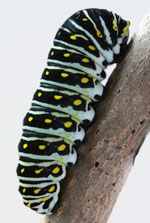 | | Black swallowtail caterpillar |
Sat. June 21, 12:00 pm:
Creating a Monarch Waystation and a Butterfly-Friendly Landscape
Northern Onondaga Library at Cicero 8686 Knowledge Ln. Cicero.
FREE and open to the public.
|
|
Central New York Land Trust Plant Sale
Sat. June 21, 11am-4pm
|
Sycamore Hill Gardens 2130 Old Seneca Turnpike, Marcellus. The gardens will be open (rain or shine) for self-guided tours. All proceeds benefit Central New York Land Trust in its work to extend protection to important habitat and natural areas in Central New York and to provide proper stewardship for the 2,836 acres it owns.
|
Since HGCNY is a chapter of the national organization Wild Ones, when you become a member of Wild Ones, you're automatically a member of HGCNY, too. And since Wild Ones is an official not-for-profit, your membership is tax-deductible.
It's easy to become a member, receive the bimonthly Wild Ones Journal, and support our mission.
|
|
As more of us participate on our Facebook page, this will become a useful resource for asking (and answering!) local HGCNYers' questions about habitat gardening.
|
|
Our Habitat Garden website
|
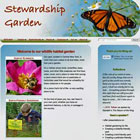 Visit Our Habitat Garden website for information on providing habitat, earth-friendly gardening practices, plants, and various creatures here in Central New York. |
Visit Our Edible Garden website to see an example of a local vegetable and fruit garden. An edible garden is a perfect complement to your habitat garden.
|
|
 |
|